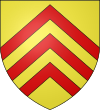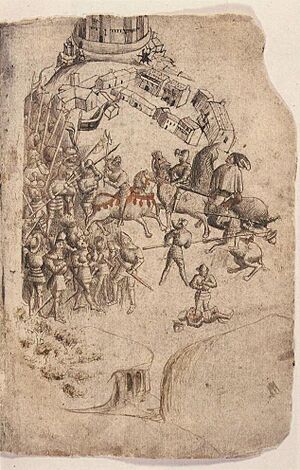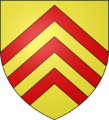Gilbert de Clare, 8th Earl of Gloucester facts for kids
Quick facts for kids
Gilbert de Clare
8th Earl of Gloucester |
|||||||||||||||||
|---|---|---|---|---|---|---|---|---|---|---|---|---|---|---|---|---|---|
| Born | c. 10 May 1291 Clare Castle, Suffolk, England
|
||||||||||||||||
| Died | 24 June 1314 (aged 23) |
||||||||||||||||
| Cause of death | Killed in battle | ||||||||||||||||
| Resting place | Tewkesbury Abbey | ||||||||||||||||
| Nationality | English | ||||||||||||||||
| Title |
List
8th Earl of Gloucester
7th Earl of Hertford 10th Lord of Clare 5th Lord of Glamorgan 10th Lord of Tonbridge 9th Lord of Cardigan |
||||||||||||||||
| Predecessor | Gilbert de Clare, 6th Earl of Hertford | ||||||||||||||||
| Successor | Earldom of Gloucester was recreated and passed to Hugh de Audley, 1st Earl of Gloucester Husband of Margaret de Clare | ||||||||||||||||
| Spouse(s) | Maud de Burgh | ||||||||||||||||
| Parent(s) | Gilbert de Clare, 7th Earl of Gloucester Princess Joan of Acre |
||||||||||||||||
|
|||||||||||||||||
Gilbert de Clare (born around 10 May 1291 – died 24 June 1314) was an important English nobleman and military leader. He was involved in the wars against Scotland. Unlike many other English earls of his time, Gilbert focused more on fighting wars than on political arguments at home.
Gilbert was the son of Gilbert de Clare, 7th Earl of Gloucester and Joan of Acre, who was the daughter of King Edward I. His father died when Gilbert was only four years old. Gilbert became an earl at the young age of sixteen. He quickly became involved in defending England's northern border. Later, he was drawn into conflicts between King Edward II and some of his powerful nobles.
Gilbert was one of the "Lords Ordainers." This group ordered the king's close friend, Piers Gaveston, to leave England in 1311. When Gaveston was killed in 1312, Gilbert helped make peace between the nobles who killed him and the king. Gilbert then became a strong supporter of King Edward II. He joined the king on a military campaign to Scotland in 1314, even when other nobles refused. Gilbert was killed at the Battle of Bannockburn on 24 June 1314. This battle was a big defeat for England. Since Gilbert had no children, his death marked the end of the powerful de Clare family line. His lands were divided among his three sisters.
Contents
Early Life and Family
Gilbert de Clare was born around 10 May 1291. His father was Gilbert de Clare, 7th Earl of Gloucester, also known as Gilbert 'the Red'. His mother was Joan of Acre, who was King Edward I's daughter. When Gilbert was born, his family's lands were secured for him. His father died on 7 December 1295, when Gilbert was still a young boy.
In 1297, Gilbert's mother, Joan, secretly married Ralph de Monthermer, 1st Baron Monthermer. He was a knight in her late husband's service. King Edward I was very angry about this because he had other marriage plans for Joan. The king even put Monthermer in prison. However, the king later agreed to the marriage. Joan kept her title as countess, and her new husband became Earl of Gloucester and Hertford. This lasted until Joan died in 1307.
Just a few months later, Gilbert received his family's lands and titles. In March 1308, he officially became the Earl of Gloucester and Hertford. He was only sixteen years old. This was granted by Edward II, who became king in July 1307. Some people used to think that Edward II and Gilbert grew up together. But this was a mistake. The Gilbert de Clare who was close to the king's age was actually Gilbert's cousin.
Serving King Edward II
When Gilbert first became an earl, he spent most of his time fighting in the Scottish Wars. He didn't have personal lands in Scotland. However, the areas in Wales where his lands were located were peaceful. So, Scotland offered a chance for him to gain military fame and rewards.
Gilbert was quickly given important military roles on the northern border. He served as the warden of Scotland from 1308 to 1309. He was also the captain of Scotland and the northern borders in 1309. In December 1308, he led a group to help the castle of Rutherglen. However, King Edward II did not fight the Scottish wars as strongly as his father had. This allowed Robert the Bruce to gain power in the war.
This situation made many English nobles unhappy. They were also upset about King Edward's close friend, Piers Gaveston. Gaveston had risen from being unknown to becoming the Earl of Cornwall. His proud behavior also angered the other nobles. Gilbert was not against Gaveston at first. Gaveston had even married Gilbert's sister, Margaret de Clare, in October 1307. But Gilbert shared the other earls' frustration with Edward's lack of action in Scotland.
In 1308, Gilbert was among the earls who demanded that Gaveston be sent away from England. The king had to agree. After this, Gilbert seemed to make up with the king. In 1309, he helped when the earls agreed to let Gaveston return. However, the relationship between the king and the nobles got worse after Gaveston came back.
In 1310, a group called the "Lords Ordainers" was formed. They were meant to create rules for King Edward II. These rules, called the Ordinances of 1311, included sending Gaveston away again. Gilbert was still a supporter of the king at first. He was not part of the Ordainers. But he was appointed to the group on 4 March 1311, after the Earl of Lincoln died.
Growing Conflict in England
Even though Gilbert was part of the group trying to reform the king's rule, he still had the king's trust. He, Gaveston, and the Earl of Warenne were the only earls to go with the king on a Scottish campaign in 1310–11. In March 1311, while the Ordinances were still being worked on, Gilbert was made guardian of the kingdom while the king was in Scotland.
There were signs that Gilbert might have had a disagreement with Thomas, Earl of Lancaster. Lancaster was the main leader of the group against the king. This disagreement was over a fight between some of their followers. However, when Gaveston returned from exile again, Gilbert sided with the nobles against the king. The earls divided the country for defense, and Gilbert was put in charge of the south.
In June 1312, Gaveston was captured by Guy de Beauchamp, Earl of Warwick. Warwick was working with Lancaster. Aymer de Valence, Earl of Pembroke had promised the king that Gaveston would be safe. Pembroke asked Gilbert for help, as Gilbert was Gaveston's relative. But Gilbert refused to help, and Gaveston was killed.
This event almost caused a civil war in England. Gilbert was one of the few people trusted by both sides. This allowed him to act as a mediator. In the months that followed, he was one of the main people who worked to create an agreement between the king and the earls who had killed Gaveston. This effort was successful for a time.
Gilbert remained close to the king for the next few months. In the summer of 1313, he was again guardian of the kingdom while the king was in France. In February 1314, he was sent to France on a diplomatic mission.
The biggest problem for the king, however, was the ongoing conflict with Scotland. Robert the Bruce was gaining strength. In the summer of 1314, Edward finally started a major campaign in Scotland. The goal was to protect the English castle at Stirling Castle from an attack by Bruce. The campaign was made harder because some important nobles, like Lancaster and Warwick, did not join.
However, many great lords were still with the king. These included Humphrey de Bohun, Earl of Hereford, Pembroke, and Gilbert. These men were valuable because they could gather many soldiers from their lands in Wales. On 23 June 1314, the royal army had passed Falkirk and was close to Stirling. But there were signs of trouble between the earls of Gloucester and Hereford. Gilbert had been given command of the English vanguard (the front part of the army). He had earned this through his loyalty to the king. But Hereford, who was under Gilbert's command, believed the command belonged to him. This was because he was the hereditary Constable of England.
Death at Bannockburn
Gilbert was involved in a small fight with the Scots on 23 June 1314. This was the day before the main battle. The king was thinking about whether to set up camp for the night or fight the Scots right away. But Gilbert and Hereford charged directly into a place called the New Park, where the Scots were camped. They did this either because they disobeyed orders or misunderstood them.
The English quickly ran into problems. Hereford's cousin, Henry de Bohun, was killed by King Robert the Bruce himself. It was probably during the retreat that Gilbert was thrown from his horse. But he managed to escape without harm. The next day, the English still weren't sure what to do. Gilbert agreed with some experienced captains who suggested that Edward should avoid battle that day. However, the younger men around the king called this cowardly and advised attacking. According to a historical account called the Vita Edwardi, when Edward became angry and accused Gilbert of treason, the earl strongly replied that he would prove his loyalty in battle.
The most detailed story of Gilbert's death at the Battle of Bannockburn comes from the Vita Edwardi Secundi. This account is written to show Gilbert as a hero and his companions as cowards. So, its historical accuracy should be considered carefully. Some stories say that Gilbert rushed into battle too quickly, seeking glory, and was killed because of his own foolishness. The Vita, however, says that as Gilbert was bravely fighting off the Scottish attacks, he was knocked off his horse and killed. His own men failed to come to his rescue. It's also likely that the arguments between Gilbert and Hereford over who was more important added to the confusion. One account says that Gilbert rushed into battle without his special coat of arms. This made him an easy target for Scottish soldiers. Otherwise, they might have tried to capture him for a valuable ransom.
After Gilbert was killed, the English army quickly fell apart. The battle ended in a huge victory for the Scots and a humiliating retreat for the English. Everyone agreed that Gilbert was the most important person to die that day. He came from a proud family and owned valuable lands. Robert the Bruce was sad about Gilbert's death. He watched over Gilbert's body at a local church (they were second cousins). Later, Bruce allowed Gilbert's body to be taken to England. Gilbert was buried at Tewkesbury Abbey, next to his father.
Aftermath and Land Division
Gilbert's death had immediate effects on politics. In his Welsh lordship of Glamorgan, the unclear situation caused a short rebellion in 1316. In Ireland, where he also owned a lot of land, his death created a power vacuum. This made it easier for Robert the Bruce's brother, Edward, to invade in 1315.
However, the biggest consequences came from dividing the de Clare family lands. In 1308, Gilbert de Clare married Maud (or Matilda) de Burgh. She was the daughter of Richard de Burgh, Earl of Ulster. The couple had no children who survived. So, Gilbert's death meant the end of the great de Clare family line. Their lands were worth as much as £6,000. This was the second largest amount of land owned by any noble family in England, after the Earl of Lancaster.
The lands went to the king while the inheritance was being decided. Maud tried to delay things by saying she was pregnant. But by 1316, it was clear she was not. Gilbert's sisters, Eleanor, Margaret (who was now a widow after Gaveston's death), and Elizabeth were all married by 1317. They married men who were close to King Edward II: Hugh Despenser the Younger, Hugh de Audley, and Roger d'Amory. The three sisters were given equal parts of the English lands. But Despenser received all of the important lordship of Glamorgan in Wales.
Despenser was not happy with his share. He used his close relationship with the king to take lands from other lords in Wales. This made lords like Hereford and Roger Mortimer angry. They started a rebellion in 1321. The rebellion was put down. But resistance continued under their ally, Thomas of Lancaster. He was defeated at the Battle of Boroughbridge in 1322 and executed.
Even though this victory temporarily made Edward's position as king stronger, he was eventually removed from power in 1326. This was done by Roger Mortimer, with the help of the king's wife, Isabella of France. The title of Earl of Gloucester was given again by Edward II's son, Edward III, in 1337, to Hugh de Audley.
Images for kids





